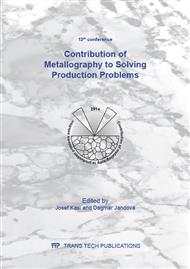p.147
p.153
p.162
p.173
p.180
p.188
p.195
p.205
p.210
Application of Stereological Relations for the Characterization of Porous Materials via Microscopic Image Analysis
Abstract:
In this work we demonstrate the application of stereology-based image analysis for the characterization of highly porous cellular ceramics (alumina foams) prepared by biological foaming with yeast and subsequent drying (80-105 °C) and firing (1570 °C). It is shown that the ceramics prepared usually have total porosities in the range 78-84 % and that the porosities made up by large pores (volume fraction of foam bubbles) are usually in the range 58-75 %. Further it is shown that the mean chord length and the Jeffries size, i.e. pore size measures related to the interface density and the mean curvature integral density, respectively, are relatively close to each other (usually 0.8-1.4 and 0.8-1.2 mm) with a ratio close to unity (0.9-1.3) and that the mean surface-to-surface distance of pores gives a realistic picture of the average pore wall thickness (usually 0.46-0.69 mm). Using a special processing variant (excess ethanol addition) it is possible to obtain microstructures with lower porosity (total porosity 68-70 %, foam bubble volume fractions 50-56 %) and smaller pore size (approx. 0.5 mm). Absolute errors are calculated using normalized deviations corresponding to 95 % reliability in the Student distribution and the standard errors for the quantities in question (both observed and estimated). Relative errors are found to be below 12 % when the number of measurements is of order 400-1000.
Info:
Periodical:
Pages:
180-187
Citation:
Online since:
May 2015
Authors:
Price:
Сopyright:
© 2015 Trans Tech Publications Ltd. All Rights Reserved
Share:
Citation:


